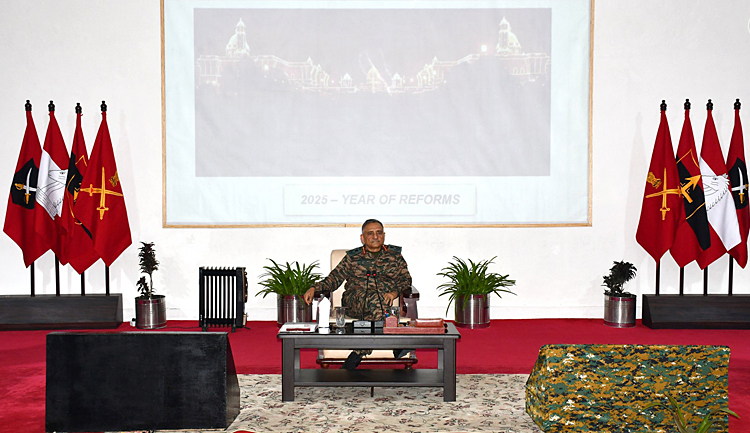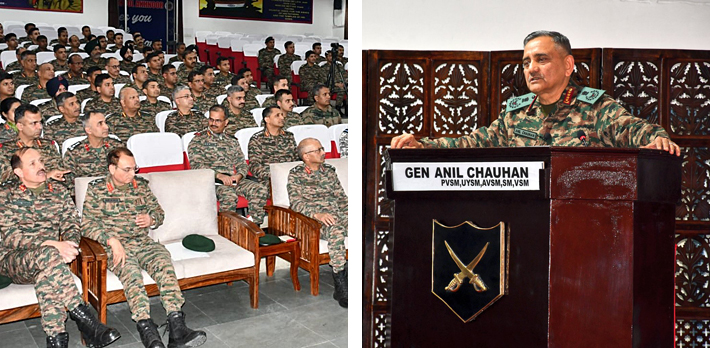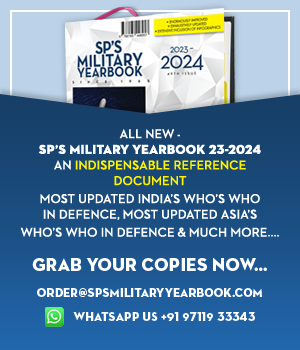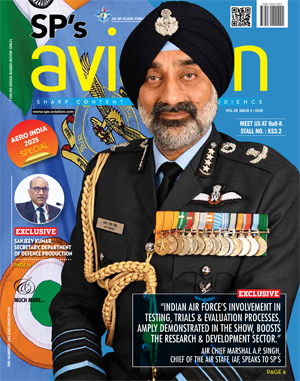INDIAN ARMED FORCES CHIEFS ON OUR RELENTLESS AND FOCUSED PUBLISHING EFFORTS

The insightful articles, inspiring narrations and analytical perspectives presented by the Editorial Team, establish an alluring connect with the reader. My compliments and best wishes to SP Guide Publications.

"Over the past 60 years, the growth of SP Guide Publications has mirrored the rising stature of Indian Navy. Its well-researched and informative magazines on Defence and Aerospace sector have served to shape an educated opinion of our military personnel, policy makers and the public alike. I wish SP's Publication team continued success, fair winds and following seas in all future endeavour!"

Since, its inception in 1964, SP Guide Publications has consistently demonstrated commitment to high-quality journalism in the aerospace and defence sectors, earning a well-deserved reputation as Asia's largest media house in this domain. I wish SP Guide Publications continued success in its pursuit of excellence.
New War Doctrine and Vision 2047
Officially to be released by mid-2025, 'Vision 2047' is a long-term plan that aims to define the role of the Armed Forces in 2047 and guide preparations for future conflicts
 |
The Author is Former Director General of Information Systems and A Special Forces Veteran, Indian Army |

It was covered in these columns in November last year that the Chief of Defence Staff (CDS), General Anil Chauhan, speaking at the India International Centre, had emphasised the necessity for the Indian Armed Forces to adopt a data-driven and integrated warfare approach. He outlined how technological advancements are reshaping modern warfare and underscored the importance of doctrinal changes to effectively engage in future conflicts. He also highlighted the need to develop new concepts of warfare, embracing innovative strategies that incorporate data-centric approaches, including joint intelligence, surveillance, and reconnaissance (ISR) to integrate military branches for enhanced operational effectiveness.
The CDS further stressed the importance of integration across the air, land, and maritime domains, suggesting that naval assets could be managed by the Air Force when necessary. He also called for original thought processes and ideas from military and academic institutions to address new warfare paradigms, emphasising the need for a distinct Indian approach, and outlined a roadmap up to 2047, which includes transitioning to an integrated all-domain force capable of responding dynamically to various conflict scenarios. He also advocated joint structures for logistics, ISR, and air defence.
Speaking recently on a podcast, the CDS outlined plans for the Armed Forces to prepare for future wars, including the development of new war doctrines and a comprehensive vision for 2047
It was also covered in these columns that while the CDS outlined a roadmap up to 2047, transitioning to an integrated all-domain force capable of responding dynamically to various conflict scenarios, the Army would need: super-cognitive 'Human-Machine Teams' supported by an upward structure; specialists for handling AI in conjunction with cyber and electronic warfare; preparing formations, units, and sub-units for the AI revolution; also raising the question of managing joint air defence with the Air Defence Command shelved.
Speaking recently on a podcast hosted by the Ministry of Defence (MoD) on its official social media channels, the CDS discussed strategies under the 'Year of Reforms 2025' initiative announced by Defence Minister Rajnath Singh. He outlined plans for the Armed Forces to prepare for future wars, including the development of new war doctrines and a comprehensive vision for 2047; announcing that joint doctrines were being formulated to address multiple facets of modern warfare, including multi-domain operations, airborne and helicopter operations, network-centric warfare, joint communications, conventional missile forces and space operations. He also said that a joint doctrine on cyber operations was released last year. With regard to 'Vision 2047' the CDS said, "We are working on it and plan to officially release it by mid-2025", adding that this long-term plan aims to define the role of the Armed Forces in 2047 and guide preparations for future conflicts.

As part of the ongoing integration of the three Armed Forces, the CDS said eight verticals have been identified, encompassing 196 specific tasks. Key short-term goals include improving operational efficiency in communications, air defence, and intelligence, surveillance and reconnaissance. An integrated capability development plan is in progress. A future technology roadmap is being developed, focusing on space warfare, quantum technologies, artificial intelligence and lethal autonomous systems.
The CDS emphasised the importance of creating integrated theatre commands, which would consolidate all warfighting assets within a defined geographical area under a single commander. Presenting a blueprint of these commands to the government remains a priority. Addressing the changing nature of warfare, he noted how emerging and disruptive technologies are reshaping conflict dynamics. The Armed Forces have divided the technology adaptation into three verticals: first, is upgrading existing systems, such as making tanks lighter while maintaining their capabilities; second, incorporating emerging technologies like artificial intelligence, expecting to impact warfare with 5-10 years; third, focussing on dual-use and disruptive technologies, which will fundamentally alter warfare.
A future technology roadmap is being developed, focusing on space warfare, quantum technologies, artificial intelligence and lethal autonomous systems
The above narrative is impressive and the Directorate of Military Affairs (DMA), headed by the CDS, would be working overtime; pressured by the political hierarchy intent upon announcing the theatre commands at the earliest opportunity. Joint doctrines have been issued by the HQ Integrated Defence Staff (IDS) in the past and we must incorporate lessons from ongoing conflicts around the world, as well as from the 2020 Chinese aggression in eastern Ladakh and the continuing India-China standoff. But saying that AI would impact warfare in 5-10 years is rather strange, because AI is already impacting warfare. AI-enabled Kamikaze drones are wreaking havoc in the war in Ukraine and Israel has been using the AI-enabled 'Lavender; system for bombings in Gaza.
The major question here is how are we working on New War Doctrine in the absence of a National Security Strategy (NSS)/Doctrine? It is on record that India has no NSS, save some instructions in bits and pieces in different ministries. The NSA Ajit Doval was officially tasked by the government but he has not done so yet, despite all the resources at his disposal. The CDS did go public last year to say we don't need a "written" NSS. Not only do we need a NSS, a comprehensive defence review is also required taking into account the emerging threats along our borders with Bangladesh and Myanmar plus the growing China-Pakistan-Bangladesh nexus – or are we going to simple ape Beijing and establish a single theatre command to look after the China border? Do we really believe that our Army's dual-tasked formations will be able to move from one theatre to another in a multi-directional threat scenario?
Working out a new war doctrine and Vision 2047, both of which would be generic, is all fine but what about our existing capability gaps and the immediate threats?
Working out a new war doctrine and Vision 2047, both of which would be generic, is all fine but what about our existing capability gaps and the immediate threats – who is accountable for these? For example, why is the fighter jet fleet of the Indian Air Force (IAF) down to around 30 squadrons? Forget offensive, how is the IAF supposed to defend the nation in a multi-directional, multi-domain war. Excuses notwithstanding, the IAF is still awaiting delivery of 40 LCA Tejas ordered a decade back. Aren't we not aware that China could deploy 1,000 J-20 'Mighty Dragon' 5th-generation jets by the time India's Advanced Medium Combat Aircraft (AMCA) starts flying. Pakistan Navy's all three French Agosta-90B (PNS Khalid, Saad, and Hamza) are powered by AIPs. Also, the Hangor submarines are expected to join the Pakistan Navy by the late 2020s and early 2030s; taking the Pakistan Navy's AIP-equipped submarine fleet strength to 11. But the Indian Navy doesn't have a single AIP powered submarine under Project 75(I), with the recent trials by Spain's Navantia and Germany's ThyssenKrupp Marine Systems (TKMS) unsuccessful. Haven't we been sleeping?
Finally, above are only two examples to remind us that amid defining hi-flying doctrines and visions, let us not forget to build our capabilities systematically; the brass tacks-level, lest we are shocked like in 1962.





